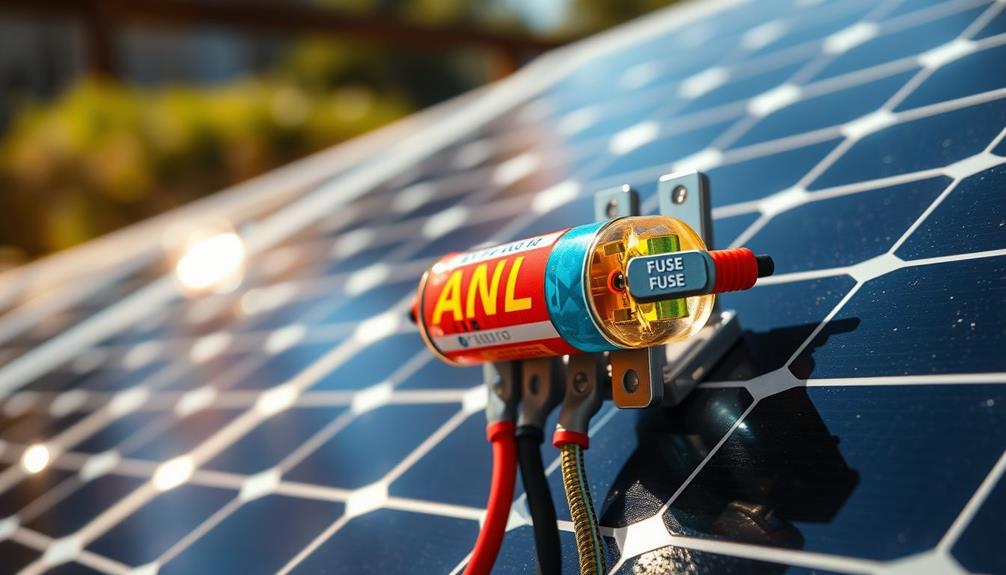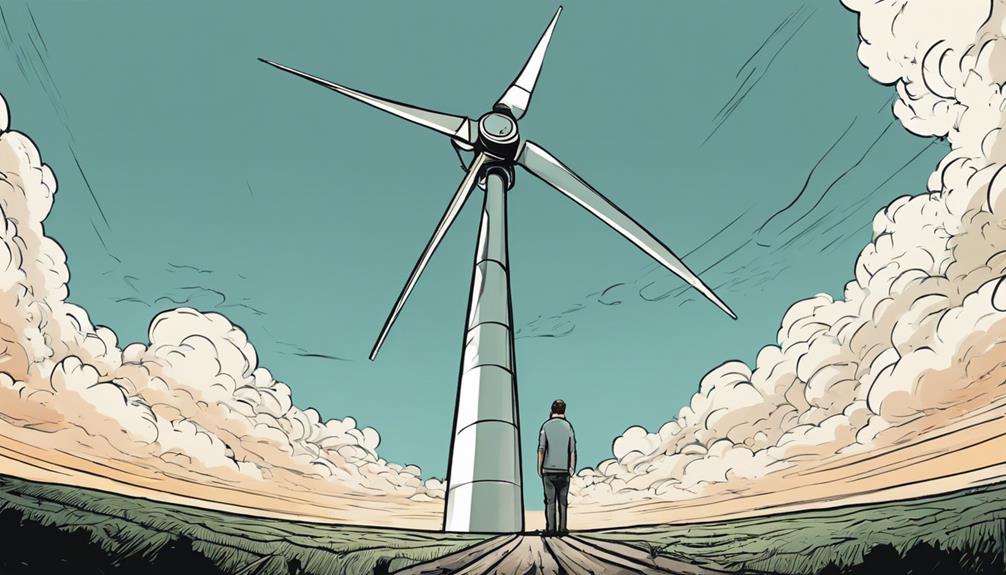If you've got a Solar Edge inverter Energy Below Threshold alert, it means your energy production has dipped below a set level. This alert warns you to act fast to address any issues and boost output efficiency. To know more about why this is happening and how to tackle it effectively, keep exploring.
Key Takeaways
- Indicates energy production below set threshold.
- Warns of system performance issues.
- Prompt action needed for shading or malfunctions.
- Monitoring software helps pinpoint causes.
- Optimize system to maximize energy production.
Understanding Energy Below Threshold Alert
If you receive a SolarEdge inverter Energy Below Threshold alert, it means that your system's energy production has dropped below the specified threshold. Monitoring this alert is important in the United States to guarantee your solar system is performing at its best.
When your system's energy production falls below the set threshold, you can expect to see this alert triggering. This serves as a warning sign that your system may not be generating the maximum output it should be.
By addressing the issues indicated by this alert promptly, such as shading, soiling, or system malfunctions, you can take steps to optimize your system's performance and maximize energy production.
Being aware of this alert and understanding its implications can help you identify and resolve any factors affecting your system's energy generation, ultimately ensuring your solar setup operates efficiently and effectively.
Common Causes of Energy Drop

When your SolarEdge inverter alerts you to an energy drop, it typically signifies a significant decrease in energy production below the specified threshold. Several common causes can lead to this drop, including shading on panels, accumulation of dirt on the system, malfunctions within the setup, or issues with individual panels.
Monitoring software plays a pivotal role in pinpointing the specific reasons behind the energy decrease, facilitating timely troubleshooting. Additionally, inverter communication errors, wiring issues, or module failures may also contribute to the decline in energy production below the set threshold.
Promptly addressing the root cause is essential to uphold optimal system performance and maximize energy generation. By identifying and resolving these common causes swiftly, you can ensure that your solar energy system operates efficiently and continues to generate the expected output.
Impact of Shading on Energy Production

Shading on solar panels can greatly reduce energy production by obstructing sunlight and limiting the panels' capacity to generate electricity. Even a small area of partial shading can cause a significant drop in energy output across the entire solar array.
Trees, buildings, or other obstructions casting shade can create 'hot spots' on panels, leading to inefficiencies and potential system damage. To combat shading effects, technologies like power optimizers or microinverters can maximize energy harvest from each panel individually.
It's vital to conduct a thorough site analysis and consider design aspects to minimize shading impact and optimize energy production from a solar PV system. By addressing shading issues proactively, you can make sure that your solar panels operate efficiently and generate the maximum amount of electricity possible.
Troubleshooting Solar Panel Malfunctions

To troubleshoot solar panel malfunctions effectively, start by checking for physical damage or loose connections that may be impacting energy production. Inspect the panels for cracks, scratches, or signs of wear that could be reducing efficiency. Verify all connections are secure and free of corrosion, as loose wiring can lead to energy production issues. Additionally, check for any dirt or debris buildup on the panels, as this can obstruct sunlight absorption. Below is a table summarizing common issues to look out for when troubleshooting solar panel malfunctions:
| Common Issues | How to Identify |
|---|---|
| Physical Damage | Look for cracks, scratches, or wear on the panels. |
| Loose Connections | Inspect wiring for any loose or corroded connections. |
| Dirt Accumulation | Check for debris buildup blocking sunlight. |
Regularly monitoring your system's performance can help catch these issues early and prevent energy below threshold alerts. Remember, when uncertain, seek professional assistance to address complex malfunctions.
System Failures and Energy Output

When your SolarEdge inverter alerts you of energy below the threshold, it's a sign that your system may not be performing at its best. Understanding the implications of this alert on your system's energy output is essential for diagnosing and resolving any underlying issues.
Taking a closer look at your system's performance can help pinpoint the root cause and make sure your solar energy production is back on track.
System Performance Analysis
Regularly monitoring your SolarEdge inverter's energy output and system performance is essential for identifying potential system failures and optimizing energy generation. By analyzing the energy output and system performance, you can pinpoint issues causing the 'Energy Below Threshold' alert, such as shading, panel malfunctions, soiling, or other system failures. This proactive approach allows you to take corrective actions promptly, preventing long-term performance issues and maximizing energy production. Understanding the reasons behind alerts like 'Energy Below Threshold' is vital for maintaining best system performance.
| System Performance Analysis | Description | Action |
|---|---|---|
| Energy Output | Monitor daily energy production trends for any deviations. | Investigate deviations promptly for potential issues. |
| System Performance | Check inverter metrics for efficiency and error messages. | Address any errors and optimize system performance. |
| Alert Investigations | Investigate all alerts to determine root causes. | Take necessary actions to resolve issues promptly. |
Energy Threshold Implications
Understanding the implications of the 'Energy Below Threshold' alert on your SolarEdge inverter involves identifying potential system failures and their impact on energy output. When this alert is triggered, it indicates that the energy being produced by your solar system is dropping below the predefined threshold.
This could indicate various system failures, such as shading from nearby objects, panel malfunctions, or even issues with the inverter itself. These failures directly impact the amount of energy your system is able to generate, potentially leading to decreased efficiency and financial losses.
By recognizing and addressing the underlying causes of low energy production promptly, you can optimize the performance of your solar energy system and make sure that it operates at its full capacity.
Regular monitoring, maintenance, and troubleshooting are essential steps in maintaining a consistent and efficient energy output from your SolarEdge inverter.
Investigating Inverter Performance Issues

Investigating inverter performance issues requires thorough analysis and diagnostic evaluation to pinpoint the root causes of energy inefficiencies.
When faced with an 'Energy Below Threshold' alert on your SolarEdge inverter, it's important to explore potential factors like shading, dirty panels, or system malfunctions impacting energy generation.
By monitoring and addressing the underlying issue promptly, you can restore your solar system's efficiency.
Regular maintenance, cleaning, and vigilant monitoring play essential roles in preventing prolonged periods of low energy production.
Understanding the reasons behind the alert is key to timely troubleshooting and optimizing your solar system's performance.
Enhancing Solar System Efficiency

To enhance your solar system efficiency, consider maximizing energy production and addressing alerts like the Solar Edge Inverter Energy Below Threshold Alert. Understanding the implications of threshold alerts can help you pinpoint issues such as shading, dirt accumulation, or system malfunctions affecting your system's performance.
Taking proactive steps to maintain and monitor your system can guarantee peak energy generation and prevent prolonged energy below threshold alerts.
Energy Efficiency Optimization
Maximizing energy efficiency in your solar system involves implementing strategies to optimize energy generation and minimize potential losses. To enhance the efficiency of your solar system, consider the following:
- Regular Maintenance:
Conduct routine checks on your solar panels, inverters, and wiring to ensure everything is functioning at its best.
- Shade Analysis:
Monitor and address any shading issues that may be affecting the performance of your solar panels, as shading can have a significant impact on energy production.
- Inverter Monitoring:
Keep a close eye on your inverter's performance and alerts, such as the Energy Below Threshold Alert, to promptly address any issues that may be impeding energy efficiency.
Threshold Alert Implications
Understanding the implications of the Energy Below Threshold Alert is vital for maximizing the efficiency of your solar system. When your system triggers this alert, it indicates a decrease in energy production below the expected level. This could be due to factors such as shading, soiling on panels, or system malfunctions hindering the best energy generation.
Promptly addressing this alert is important as it can help enhance system efficiency and maximize energy output. Regularly monitoring your system's performance enables you to identify and resolve issues leading to energy production below the set threshold.
Addressing Inverter Energy Limitations

When dealing with the 'Energy Below Threshold' alert on your Solar Edge inverter, it's important to address the limitations affecting energy production. To optimize your system's performance, consider the following:
- Shading Issues: Identify any obstructions casting shadows on your solar panels, as shading can significantly impact energy production.
- Panel Orientation: Confirm that your solar panels are facing the correct direction to receive maximum sunlight exposure throughout the day.
- Inverter Power Limitations: Check if your inverter is appropriately sized for your system's capacity, as an undersized inverter can lead to energy constraints.
Optimizing Solar Energy Generation

To optimize your solar energy generation, analyzing the threshold alert can provide valuable insights into your system's efficiency. By understanding the triggers behind the alert and taking proactive steps to address them, you can maximize energy output and overall performance.
Enhancing Solar Edge efficiency through prompt actions based on alert analysis can greatly boost your system's energy generation capabilities.
Energy Generation Optimization
For maximizing solar energy generation, consistently monitoring and addressing alerts like the Energy Below Threshold on a SolarEdge inverter is crucial. When aiming to optimize your energy generation, it's vital to take proactive steps in response to these alerts.
Here are key actions to enhance your solar energy system's performance:
- Identify the Cause: Investigate the reasons behind the Energy Below Threshold alert, which could range from shading issues to system malfunctions or soiling affecting energy production.
- Take Prompt Action: Address the root cause promptly to ensure that your system operates efficiently and at peak capacity.
- Regular Monitoring: Regularly check for alerts like Energy Below Threshold to maintain peak energy production levels and overall system efficiency.
Threshold Alert Analysis
Exploring the analysis of threshold alerts is essential to maximizing solar energy generation and enhancing system efficiency.
When your SolarEdge Inverter Energy Below Threshold Alert triggers, it indicates that your energy production has dipped below a set level. This alert serves as a valuable tool in pinpointing issues that may be hindering your system's performance, such as shading, panel faults, or dirt build-up.
By closely monitoring these alerts, you can swiftly address any potential problems, ensuring your solar setup operates at its peak efficiency.
Customizing the threshold level based on your specific system requirements and preferences is vital for maintaining ideal energy generation. Timely responses to these alerts through maintenance and troubleshooting can prevent prolonged energy losses, safeguarding the benefits of your solar energy investment.
Solar Edge Efficiency
When your SolarEdge inverter effectively enhances solar energy generation, it maximizes system performance and output. This efficiency is essential for converting sunlight into usable electricity, reducing energy waste, and maximizing overall output.
Monitoring energy production is key to identifying any issues or inefficiencies within the system promptly. By addressing these efficiency concerns, you can guarantee your solar system operates at its peak performance, ultimately leading to increased energy savings.
Here are some key points to keep in mind:
- Enhancing Efficiency: Solar Edge inverters are designed to optimize efficiency and performance, ensuring that you get the most out of your solar energy system.
- Minimizing Energy Waste: Effective energy conversion minimizes waste, allowing you to make the most of the sunlight your panels capture.
- Monitoring for Enhancements: Regular monitoring helps detect any issues early on, enabling you to make timely enhancements and maintain optimal energy production levels.
Recommendations for System Improvement

To boost your system's performance and prevent recurring Energy Below Threshold alerts, consider implementing the following suggestions for improvement:
| Suggestions for System Enhancement | Description |
|---|---|
| Adjust inverter configurations or power limit | Tweaking these configurations can help avoid the alert from triggering due to fluctuations in energy production. |
| Monitor system efficiency regularly | Keeping an eye on efficiency will allow you to catch any issues early on and address them promptly to avoid energy drops. |
| Evaluate shading, panel orientation, and design | Optimizing these elements will maximize energy production and minimize the chances of the alert being activated. |
| Maintain panels, inverters, and components | Proper upkeep ensures peak performance and prevents energy output from falling below the threshold, triggering alerts. |
| Seek advice from a solar energy professional | Consulting with an expert for a thorough system assessment will provide tailored recommendations to address the Energy Below Threshold alert effectively. |
Frequently Asked Questions
What Are the Warning Lights on Solaredge?
Warning lights on SolarEdge inverters provide essential system information. They alert you to issues like Energy Below Threshold, indicating lower energy production. Promptly addressing shading, panel damage, or soiling can resolve this alert and optimize system performance.
How to Tell if a Solaredge Inverter Is Working?
To check if your Solaredge inverter is working, monitor the green indicators and energy production graphs on the monitoring platform. Look for consistent output levels and receive alerts if it falls below the threshold.
How to Reset Solaredge Inverter?
To reset your SolarEdge inverter, locate the 'on/off' button on the front display panel. Press and hold for 5 seconds until the LED turns off, then release. Wait 2 minutes for restart. Check monitoring platform for online status.
How Do I Get My Solaredge Inverter Out of Standby Mode?
Feeling stuck with your SolarEdge inverter in standby mode? Check the DC disconnect, flip the AC breaker, and scan for error messages. Confirm proper power supply. If still puzzled, try resetting and reviewing the manual or contact support.
How Does Ionization Energy Relate to Solar Edge Inverter Energy Threshold Alerts?
The ionization energy explained is the amount of energy needed to remove an electron from an atom. In the context of solar edge inverter energy threshold alerts, understanding ionization energy can help optimize the performance of the inverter by ensuring that the right amount of energy is being utilized.
Conclusion
So, next time you see that energy below threshold alert on your solar edge inverter, don't panic. It's like hitting a speed bump on the road – a little setback that can be overcome with the right adjustments.
Just like how you adjust your driving to navigate the bump smoothly, you can make tweaks to your solar system to optimize energy production.
Stay proactive, stay informed, and keep your solar energy journey on the right track.










